Performance Investigation of High Temperature Application of Molten Solar Salt Nanofluid in a Direct Absorption Solar Collector
Abstract
1. Introduction
- DACs do not require a surface absorption plate, which results in a significantly simpler receiver design and reduced cost and labour, as surface-absorbing plates require complex manufacturing processes [23]
2. Model Development
2.1. Model Setup
2.2. Modelling Optical Properties of the Nanofluid
2.3. Governing Equations
2.4. Solution Procedure
2.4.1. Model Parameters and Variables
2.4.2. Initial and Boundary Conditions
2.4.3. Grid Generation
2.4.4. Thermo-Physical Properties of Nanofluid
2.4.5. Model Validation
3. Results and Discussion
3.1. Effect of Receiver Length and Height on the Efficiencies
3.2. Effect of Inlet Velocity on the Efficiencies
3.3. Effect of Solar Concentrations on the Efficiencies
4. Conclusions
Author Contributions
Funding
Acknowledgments
Conflicts of Interest
Nomenclature
| Collector area (m2). | |
| ao and a1 | Constant parameters. |
| Absorptive index. | |
| C | Concentration factor (×). |
| c | Speed of light (m/s). |
| Specific heat (W/mK). | |
| D | Particle diameter (m). |
| Volume fraction of nanoparticles. | |
| Planck’s constant. | |
| Overall heat transfer coefficient (W/mK). | |
| Nanofluid heat transfer coefficient (W/mK). | |
| Incident radiation (W/m2). | |
| Scattered irradiation (W/m2). | |
| k | Thermal conductivity (W/m2K). |
| Boltzmann constant. | |
| Thermal conductivity of nanofluid (W/m2K). | |
| Thermal conductivity of top plate (W/m2K). | |
| L | Characteristic length taken as receiver height (m). |
| Length of receiver (m). | |
| m | Relative complex refractive index of the nanofluid= Snp / Sbf. |
| Mass flow rate (kg/s). | |
| N | Number of scattering particles in the beam path. |
| Nusselt number. | |
| Refractive index. | |
| Solar irradiance integrated over solar wavelength range (W/m2). | |
| Pr | Prandtl number. |
| Q | Heat source (W). |
| Re | Reynolds number. |
| Attenuation constant: which accounts for the average attenuation through Earth’s atmosphere. | |
| Complex refractive index of the base fluid. | |
| Strength of the jth resonant vibration mode. | |
| Complex refractive index of the nanoparticles. | |
| T | Temperature (K). |
| Ambient temperature (K). | |
| Inlet temperature (K). | |
| Average outlet temperature (K). | |
| Temperature of the sun (K). | |
| t | Thickness of top plate (m). |
| u | Fully developed velocity (m/s). |
| Inlet nanofluid velocity (m/s). | |
| Greek symbols | |
| ϑ | Scattering angle. |
| Solid angle of the sun as seen from Earth (steradian). | |
| Damping parameter of the jth resonant vibration mode. | |
| Maximum packing concentration. | |
| Receiver efficiency (%). | |
| Carnot efficiency (%). | |
| Total efficiency (%). | |
| λ | Radiation wavelength (m). |
| Characteristic wavelength of the jth resonant vibration mode (m). | |
| θ | Incident angle (rad). |
| ρ | Density (kg/m3). |
References
- Arthur, O.; Karim, M.A. An investigation into the thermophysical and rheological properties of nanofluids for solar thermal applications. Renew. Sustain. Energy Rev. 2016, 55, 739–755. [Google Scholar] [CrossRef]
- Chieruzzi, M.; Cerritelli, G.F.; Miliozzi, A.; Kenny, J.M. Effect of nanoparticles on heat capacity of nanofluids based on molten salts as PCM for thermal energy storage. Nanoscale Res. Lett. 2013, 8, 448. [Google Scholar] [CrossRef] [PubMed]
- Karim, A.; Burnett, A.E.; Fawzia, S. Investigation of stratified thermal storage tank performance for heating and cooling applications. Energies 2018, 11, 1049. [Google Scholar] [CrossRef]
- Karim, A. Experimental investigation of a stratified chilled-water thermal storage system. Appl. Therm. Eng. 2011, 31, 1853–1860. [Google Scholar] [CrossRef]
- Karim, A.; Perez, E.; Amin, Z.M. Mathematical modelling of counter flow v-grove solar air collector. Renew. Energy Int. J. 2014, 67, 192–201. [Google Scholar] [CrossRef]
- Karim, A.; Hawlader, M.N.A. Performance investigation of flat plate, v-corrugated and finned air collectors. Energy 2006, 31, 452–470. [Google Scholar] [CrossRef]
- Islam, M.; Karim, A.; Saha, S.C.; Miller, S.; Yarlagadda, P.K. Three dimensional simulation of a parabolic trough concentrator thermal collector. In Proceedings of the 50th Annual Conference, Australian Solar Energy Society (AuSES), Melbourne, Australia, 6–7 December 2012. [Google Scholar]
- Islam, M.; Saha, S.C.; Karim, M.A.; Yarlagadda, P.K.D.V. A Method of Three-Dimensional Thermo-Fluid Simulation of the Receiver of a Standard Parabolic Trough Collector. In Application of Thermo-Fluid Processes in Energy Systems: Key Issues and Recent Developments for a Sustainable Future; Khan, M.M.K., Chowdhury, A.A., Hassan, N.M.S., Eds.; Springer: Singapore, 2018; pp. 203–230. [Google Scholar]
- Islam, M.; Karim, A.; Saha, S.C.; Yarlagadda, P.K.; Miller, S.; Ullah, I. Visualization of thermal characteristics around the absorber tube of a standard parabolic trough thermal collector by 3D simulation. In Proceedings of the 4th International Conference on Computational Methods (ICCM2012), Gold Coast, Australia, 25–27 November 2012. [Google Scholar]
- Karim, A.; Hawlader, M.N.A. Performance evaluation of a v-groove solar air collector for drying applications. Appl. Therm. Eng. 2006, 28, 121–130. [Google Scholar] [CrossRef]
- Karim, A.; Hawlader, M.N.A. Development of solar air collectors for drying applications. Energy Convers. Manag. 2004, 45, 329–344. [Google Scholar] [CrossRef]
- Bogaerts, W.F.; Lampert, C.M. Materials for photothermal solar energy conversion. J. Mater. Sci. 1983, 18, 2847–2875. [Google Scholar] [CrossRef]
- Islam, M.; Miller, S.; Yarlagadda, P.K.; Karim, A. Investigation of the effect of physical and optical factors on the optical performance of a parabolic trough collector. Energies 2017, 10, 1907. [Google Scholar] [CrossRef]
- Islam, M.; Karim, M.A.; Saha, S.C.; Miller, S.; Yarlagadda, P.K.D.V. Development of Empirical Equations for Irradiance Profile of a Standard Parabolic Trough Collector Using Monte Carlo Ray Tracing Technique. Adv. Mater. Res. 2014, 860–863, 180–190. [Google Scholar] [CrossRef]
- Islam, M.; Yarlagadda, P.; Karim, A. Effect of the Orientation Schemes of the Energy Collection Element on the Optical Performance of a Parabolic Trough Concentrating Collector. Energies 2018, 12, 128. [Google Scholar] [CrossRef]
- Kaluri, R.; Vijayaraghavan, S.; Ganapathisubbu, S. Model development and performance studies of a concentrating direct absorption solar collector. J. Sol. Energy Eng. 2015, 137, 021005. [Google Scholar] [CrossRef]
- Viskanta, R. Direct Absorption Solar Radiation Collection Systems. In Solar Energy Utilization; NATO ASI Series (Series E: Applied Sciences); Yüncü, H., Paykoc, E., Yener, Y., Eds.; Springer: Dordrecht, The Netherlands, 1987. [Google Scholar]
- Cengel, Y.; Özişik, M. Solar radiation absorption in solar ponds. Sol. Energy 1984, 33, 581–591. [Google Scholar] [CrossRef]
- Beard, J.; Iachetta, F.; Lilleleht, L.; Huckstep, F.; May, W. Design and Operational Influences on Thermal Performance of “Solaris” Solar Collector. J. Eng. Power 1978, 100, 497–502. [Google Scholar] [CrossRef]
- Arai, N.; Itaya, Y.; Hasatani, M. Development of a “volume heat-trap” type solar collector using a fine-particle semitransparent liquid suspension (FPSS) as a heat vehicle and heat storage medium Unsteady, one-dimensional heat transfer in a horizontal FPSS layer heated by thermal radiation. Sol. Energy 1984, 32, 49–56. [Google Scholar] [CrossRef]
- Taylor, R.A.; Phelan, P.E.; Otanicar, T.P.; Walker, C.A.; Nguyen, M.; Trimble, S.; Prasher, R. Applicability of nanofluids in high flux solar collectors. J. Renew. Sustain. Energy 2011, 3, 023104. [Google Scholar] [CrossRef]
- Tiznobaik, H.; Shin, D. Enhanced specific heat capacity of high-temperature molten salt-based nanofluids. Int. J. Heat Mass Transf. 2013, 57, 542–548. [Google Scholar] [CrossRef]
- Lee, S.H.; Jang, S.P. Efficiency of a volumetric receiver using aqueous suspensions of multi-walled carbon nanotubes for absorbing solar thermal energy. Int. J. Heat Mass Transf. 2015, 80, 58–71. [Google Scholar] [CrossRef]
- Lee, J.H.; Lee, S.H.; Choi, C.; Jang, S.; Choi, S. A review of thermal conductivity data, mechanisms and models for nanofluids. Int. J. Micro-Nano Scale Transp. 2011. [Google Scholar] [CrossRef]
- Paul, T.C.; Morshed, A.; Fox, E.B.; Visser, A.E.; Bridges, N.J.; Khan, J.A. Enhanced thermal performance of ionic liquid-Al2O3 nanofluid as heat transfer fluid for solar collector. In Proceedings of the ASME 2013 7th International Conference on Energy Sustainability Collocated with the ASME 2013 Heat Transfer Summer Conference and the ASME 2013 11th International Conference on Fuel Cell Science, Engineering and Technology, Minneapolis, MN, USA, 14–19 July 2013. [Google Scholar]
- Tyagi, H.; Phelan, P.; Prasher, R. Predicted efficiency of a low-temperature nanofluid-based direct absorption solar collector. J. Sol. Energy Eng. 2009, 131, 041004. [Google Scholar] [CrossRef]
- Otanicar, T.P.; Phelan, P.E.; Prasher, R.S.; Rosengarten, G.; Taylor, R.A. Nanofluid-based direct absorption solar collector. J. Renew. Sustain. Energy 2010, 2, 033102. [Google Scholar] [CrossRef]
- Taylor, R.A.; Phelan, P.E.; Otanicar, T.P.; Adrian, R.; Prasher, R. Nanofluid optical property characterization: Towards efficient direct absorption solar collectors. Nanoscale Res. Lett. 2011, 6, 225. [Google Scholar] [CrossRef] [PubMed]
- Veeraragavan, A.; Lenert, A.; Yilbas, B.; Al-Dini, S.; Wang, E.N. Analytical model for the design of volumetric solar flow receivers. Int. J. Heat Mass Transf. 2012, 55, 556–564. [Google Scholar] [CrossRef]
- Lenert, A.; Wang, E.N. Optimization of nanofluid volumetric receivers for solar thermal energy conversion. Sol. Energy 2012, 86, 253–265. [Google Scholar] [CrossRef]
- Luo, Z.; Wang, C.; Wei, W.; Xiao, G.; Ni, M. Performance improvement of a nanofluid solar collector based on direct absorption collection (DAC) concepts. Int. J. Heat Mass Transf. 2014, 75, 262–271. [Google Scholar] [CrossRef]
- Parvin, S.; Nasrin, R.; Alim, M. Heat transfer and entropy generation through nanofluid filled direct absorption solar collector. Int. J. Heat Mass Transf. 2014, 71, 386–395. [Google Scholar] [CrossRef]
- Jo, B.; Banerjee, D. Enhanced specific heat capacity of molten salt-based nanomaterials: Effects of nanoparticle dispersion and solvent material. Acta Mater. 2014, 75, 80–91. [Google Scholar] [CrossRef]
- Yung, C.F.; Yeh, H.Y.; Lee, C.D.; Wu, J.L.; Zhou, P.C.; Feng, J.C.; Wang, H.X.; Peng, S.J. Optimal regional pole placement for sun tracking control of high-concentration photovoltaic (HCPV) systems: Case study. Optim. Control Appl. Methods 2010, 31, 581–591. [Google Scholar] [CrossRef]
- Zhang, L.; Liu, J.; He, G.; Ye, Z.; Fang, X.; Zhang, Z. Radiative properties of ionic liquid-based nanofluids for medium-to-high-temperature direct absorption solar collectors. Sol. Energy Mater. Sol. Cells 2014, 130, 521–528. [Google Scholar] [CrossRef]
- Bohren, C.; Huffman, D. Absorption and Scattering of Light by Small Particles; Wiley: New York, NY, USA, 1983. [Google Scholar]
- Modest, M.F. Radiative Heat Transfer; Academic Press: Cambridge, MA, USA, 2013. [Google Scholar]
- Brewster, M.; Tien, C. Radiative transfer in packed fluidized beds: Dependent versus independent scattering. J. Heat Transf. 1982, 104, 573–579. [Google Scholar] [CrossRef]
- Kitamura, R.; Pilon, L.; Jonasz, M. Optical constants of silica glass from extreme ultraviolet to far infrared at near room temperature. Appl. Opt. 2007, 46, 8118–8133. [Google Scholar] [CrossRef] [PubMed]
- Miller, F.J.; Koenigsdorff, R.W. Thermal modeling of a small-particle solar central receiver. J. Sol. Energy Eng. 2000, 122, 23–29. [Google Scholar] [CrossRef]
- Serrano-López, R.; Fradera, J.; Cuesta-López, S. Molten salts database for energy applications. In Chemical Engineering and Processing: Process Intensification; Universidad de Burgos: Burgos, Spain, 2013; Volume 73, pp. 87–102. [Google Scholar]
- Incorperated, S. Therminol VP-1 Vapor Phase/Liquid Phase Heat Transfer Fluid. Therminol VP-1 Data Sheet. 2013. Available online: https://www.therminol.com/products/Therminol-VP1 (accessed on 14 January 2018).
Sample Availability: Not available. |
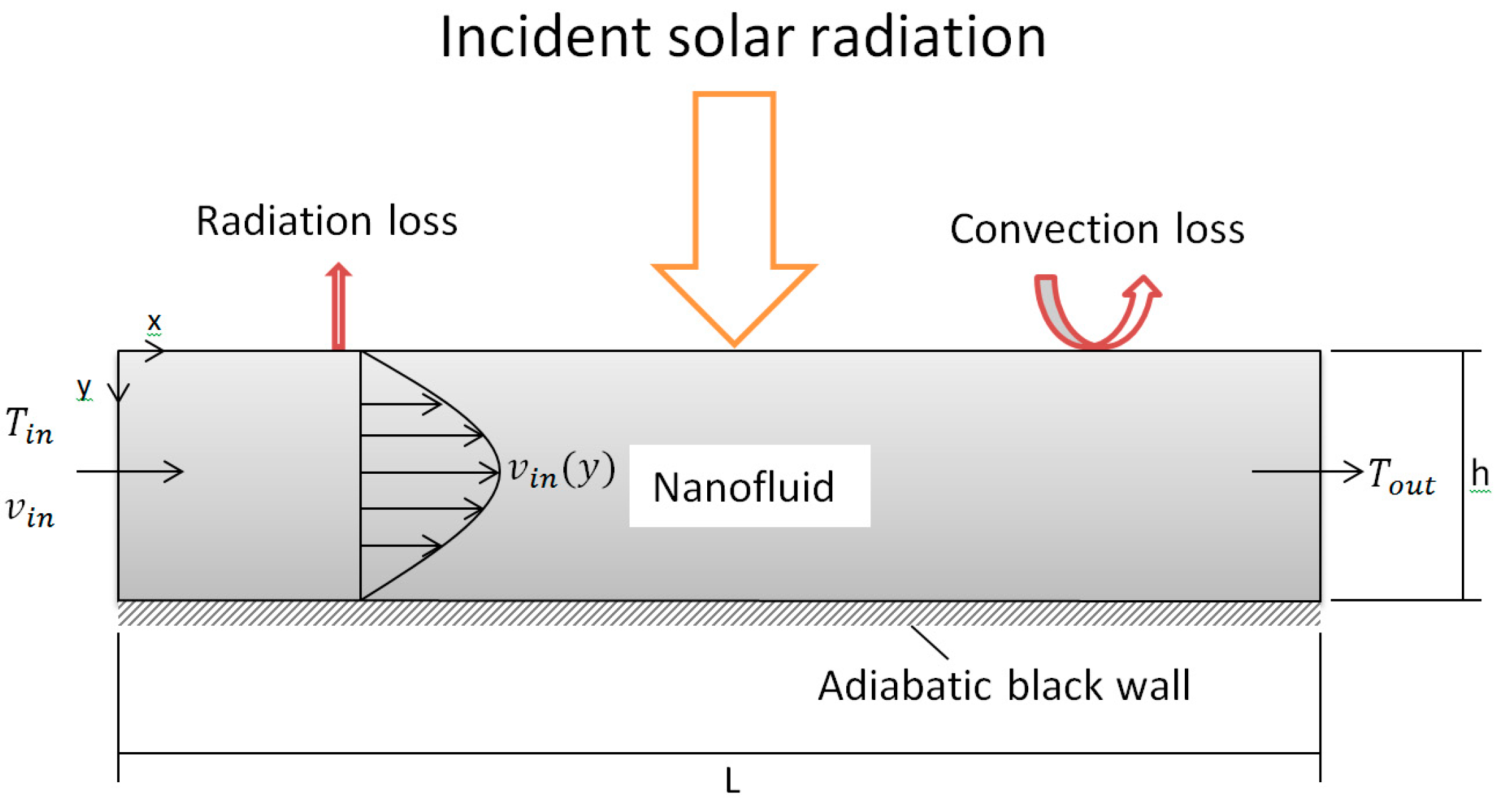
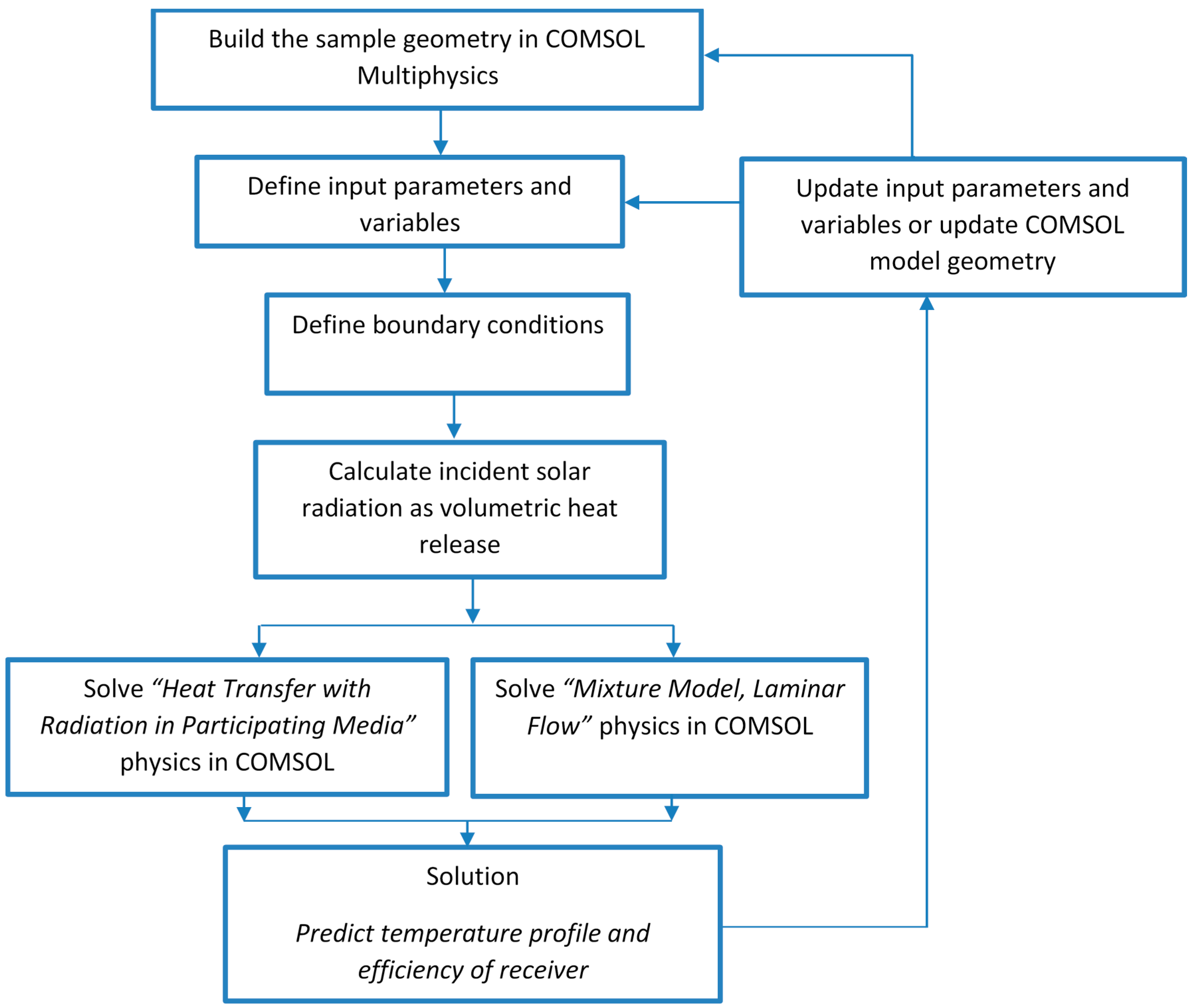
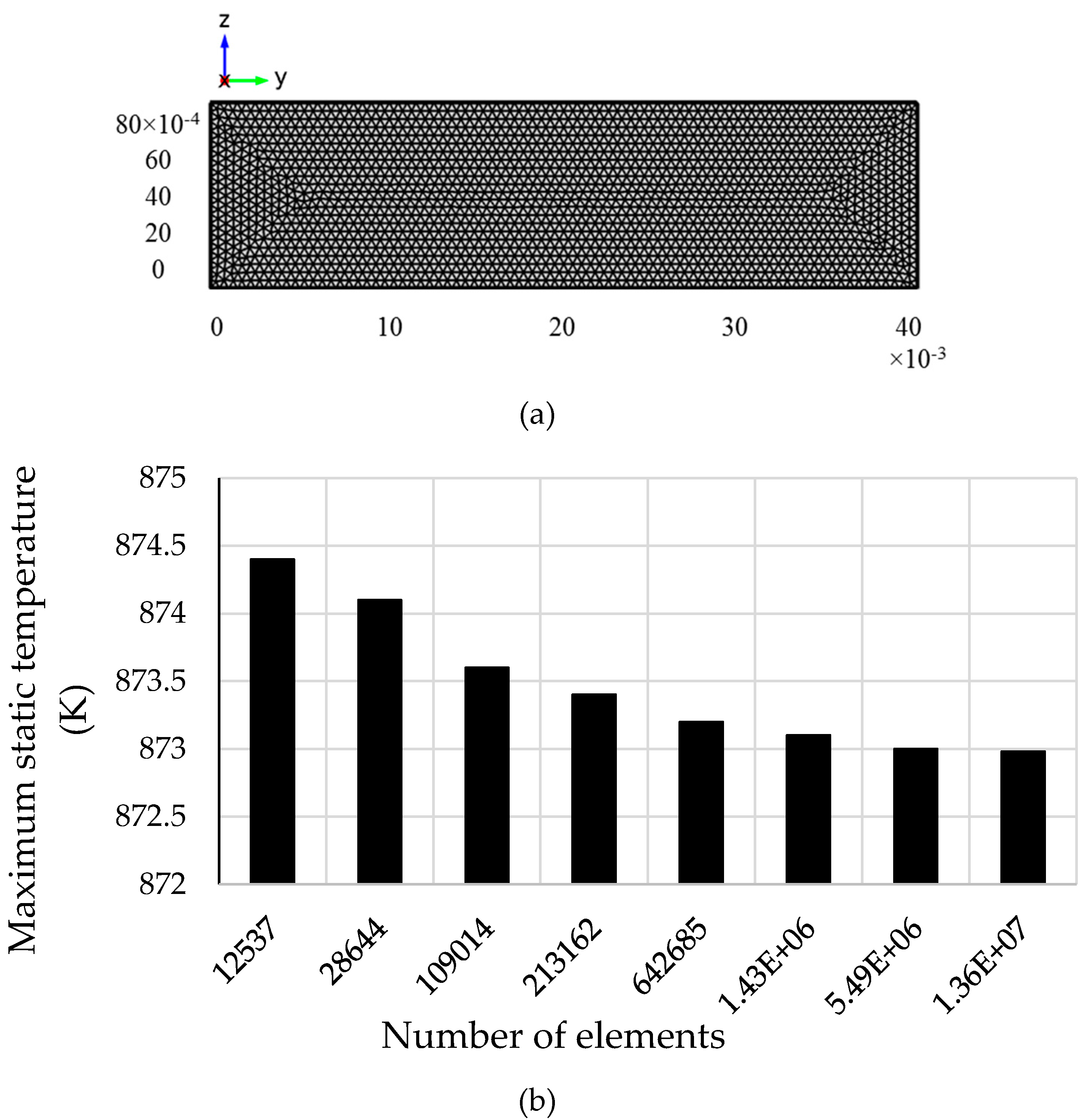
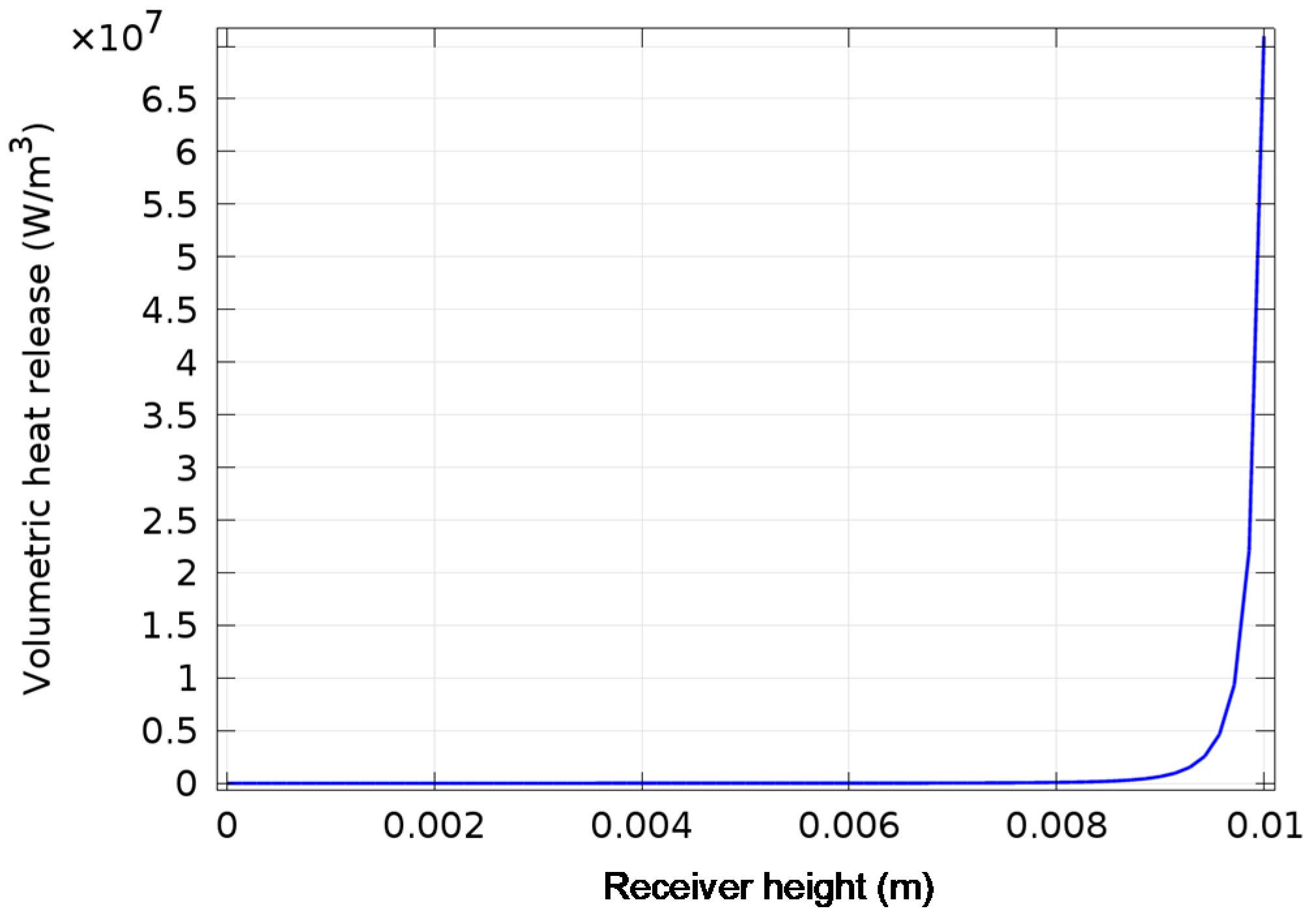
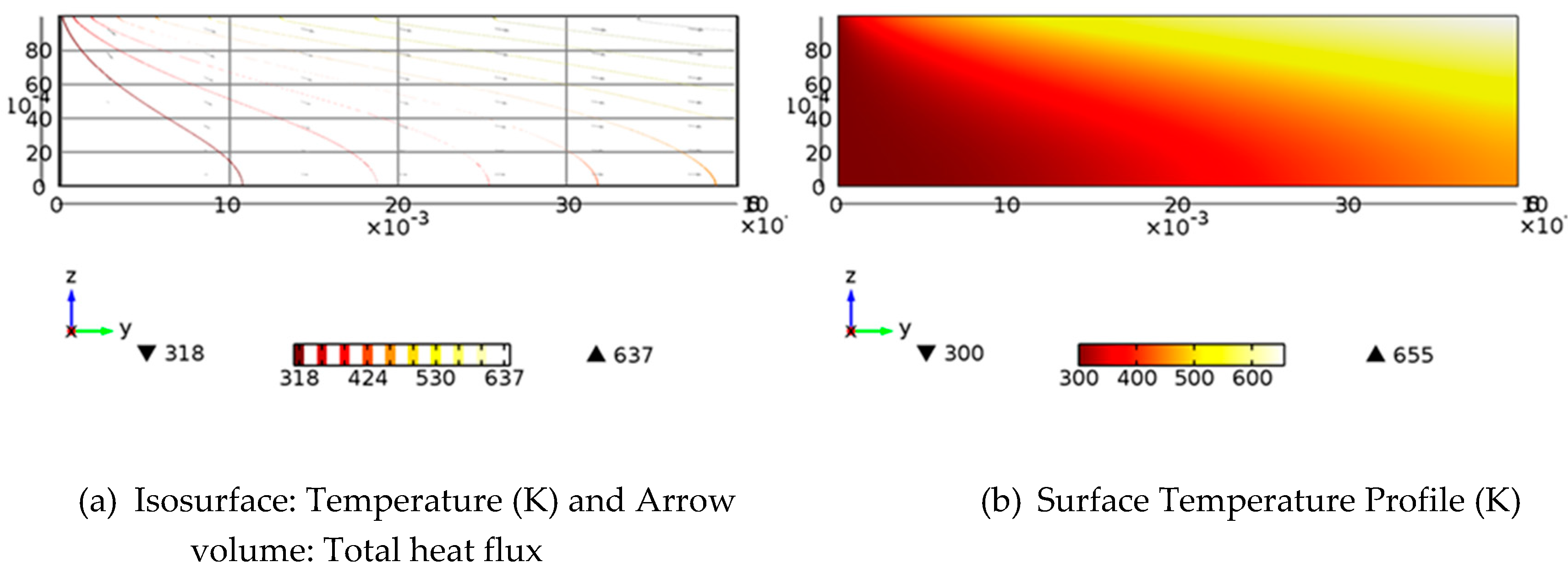
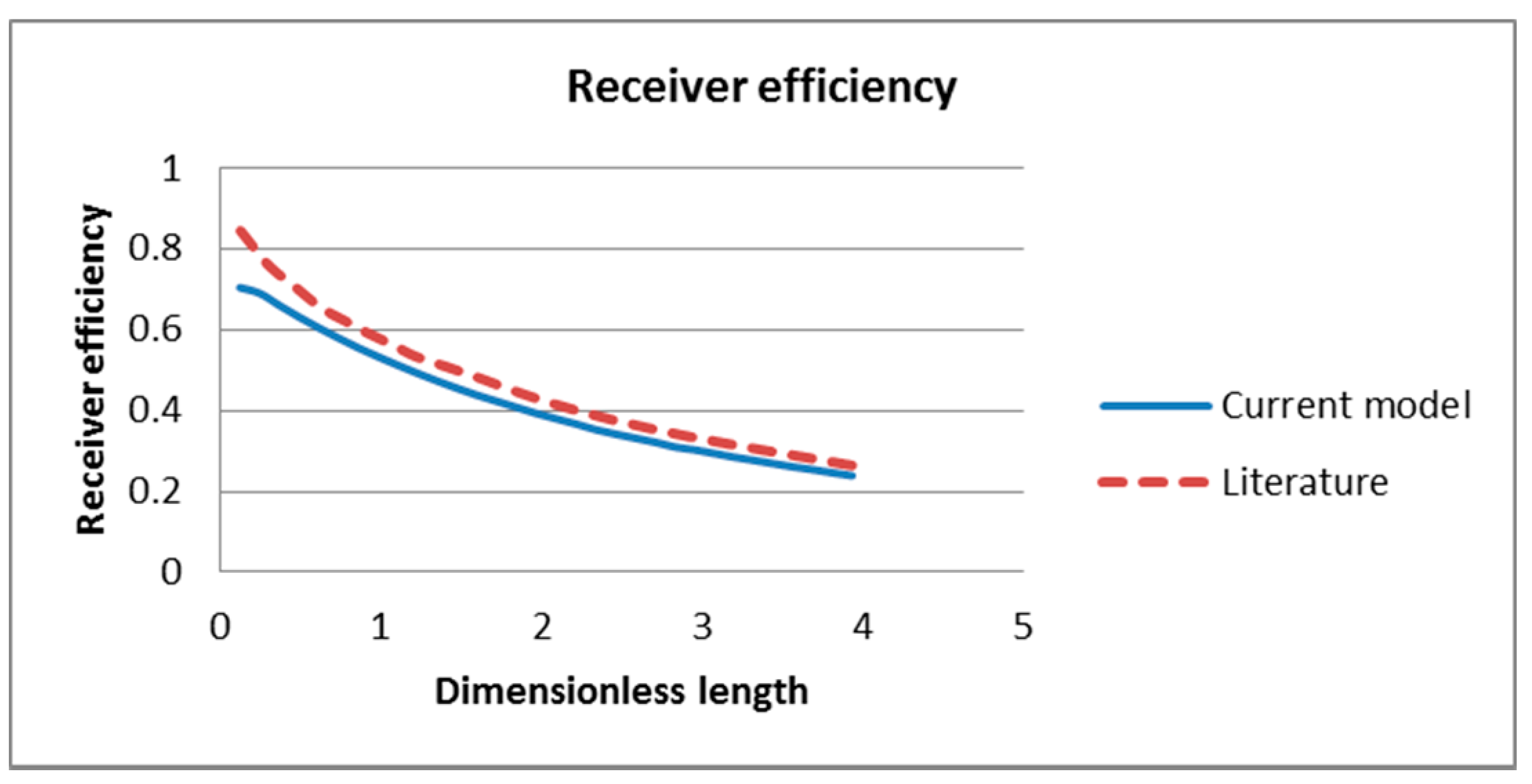
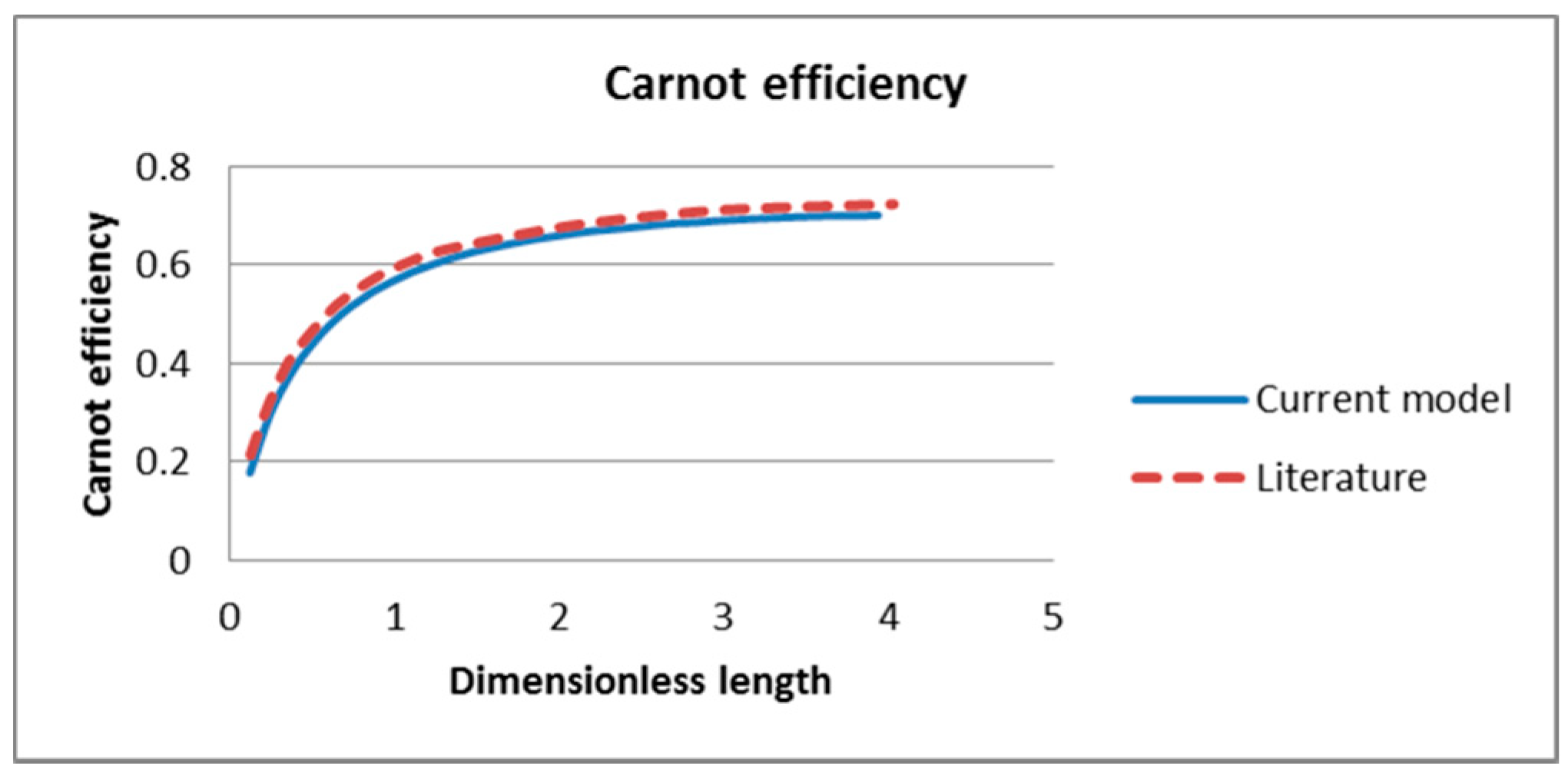
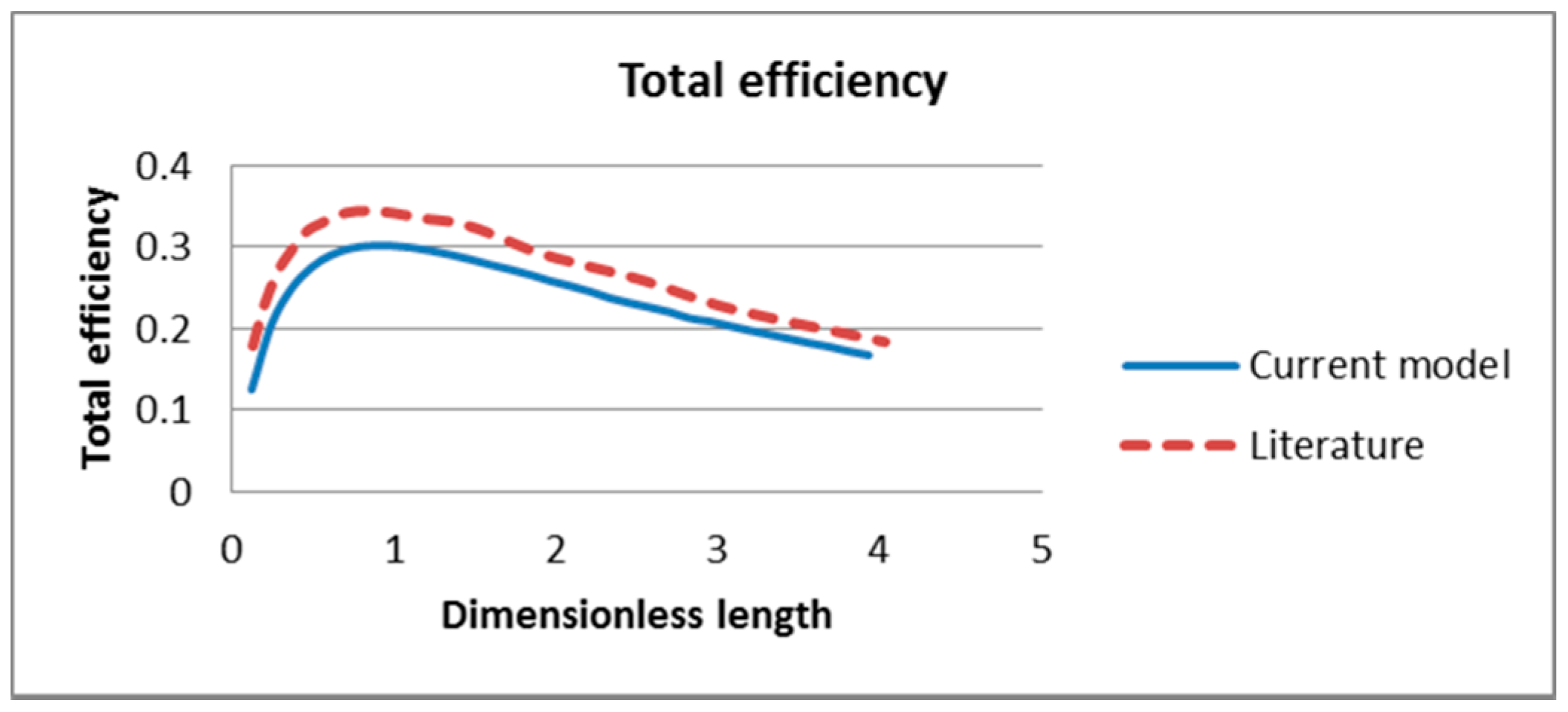
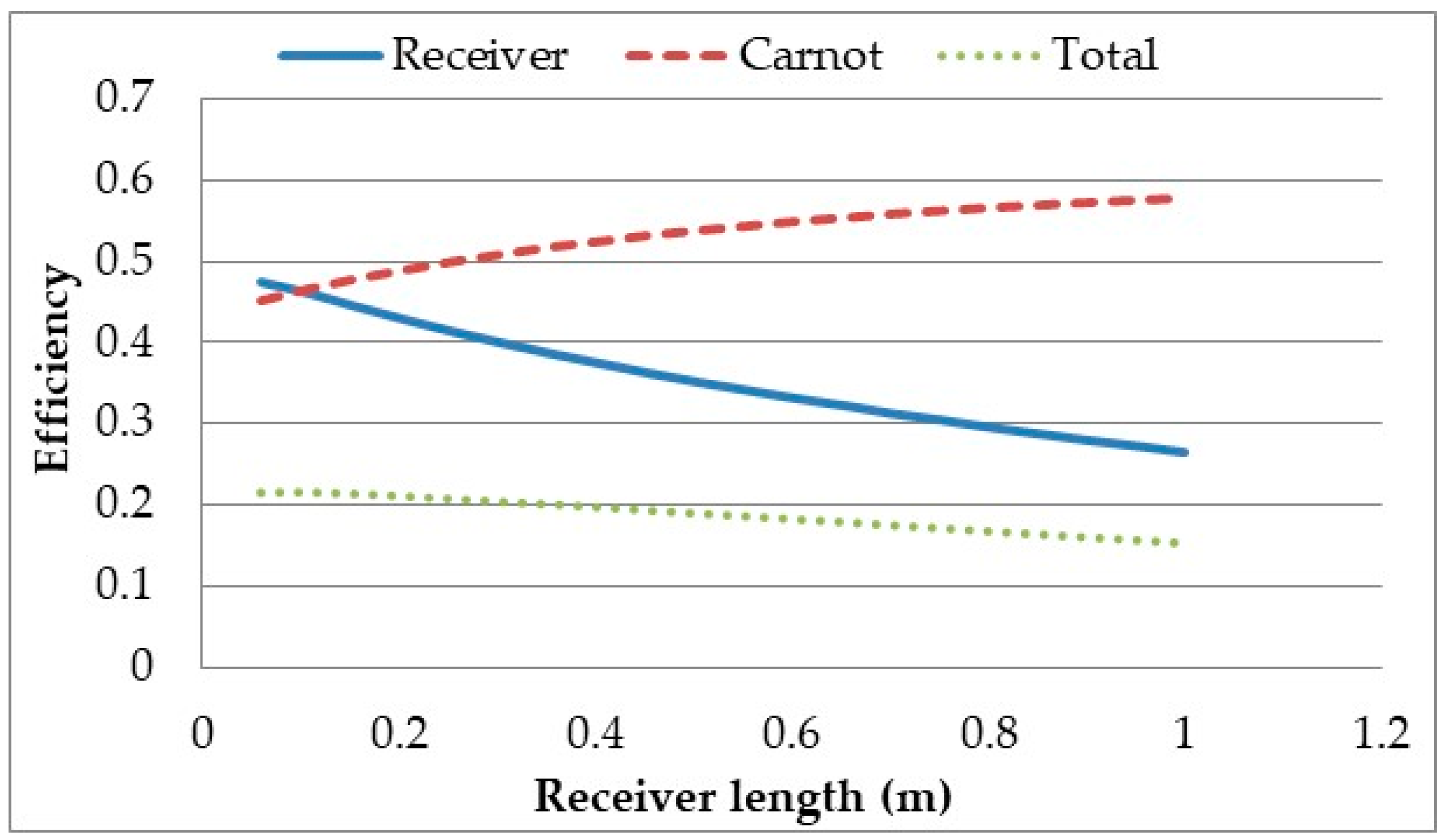
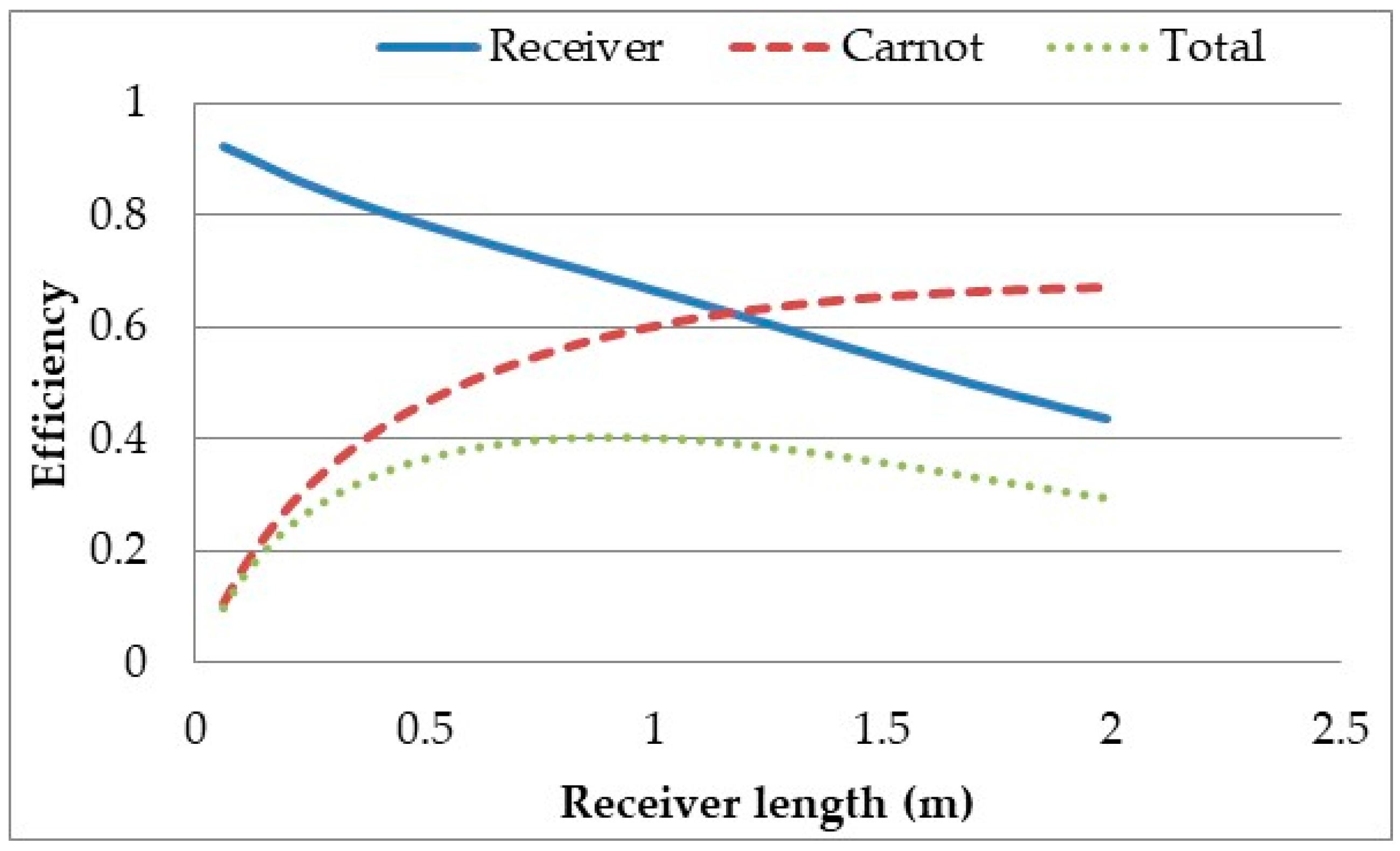
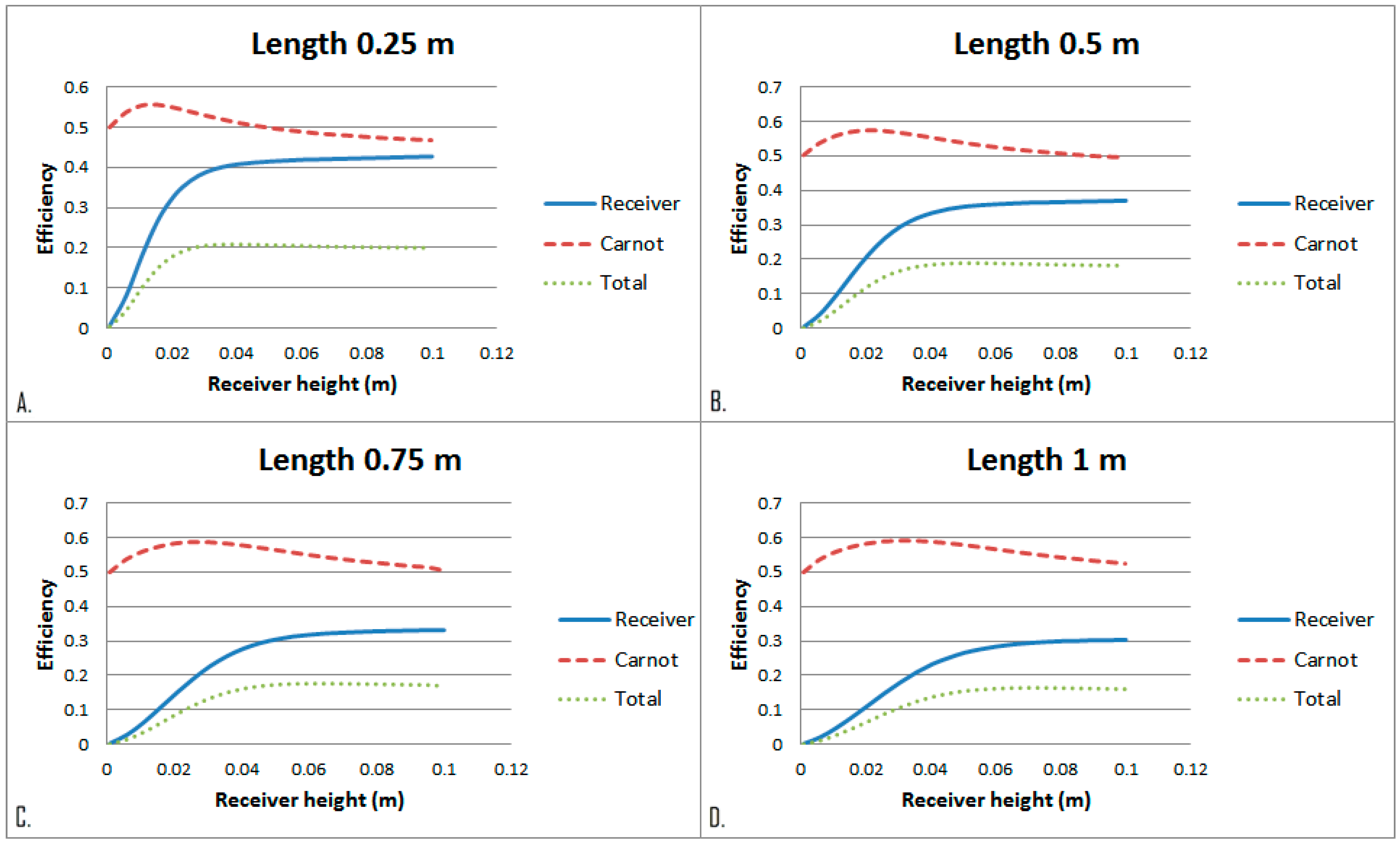
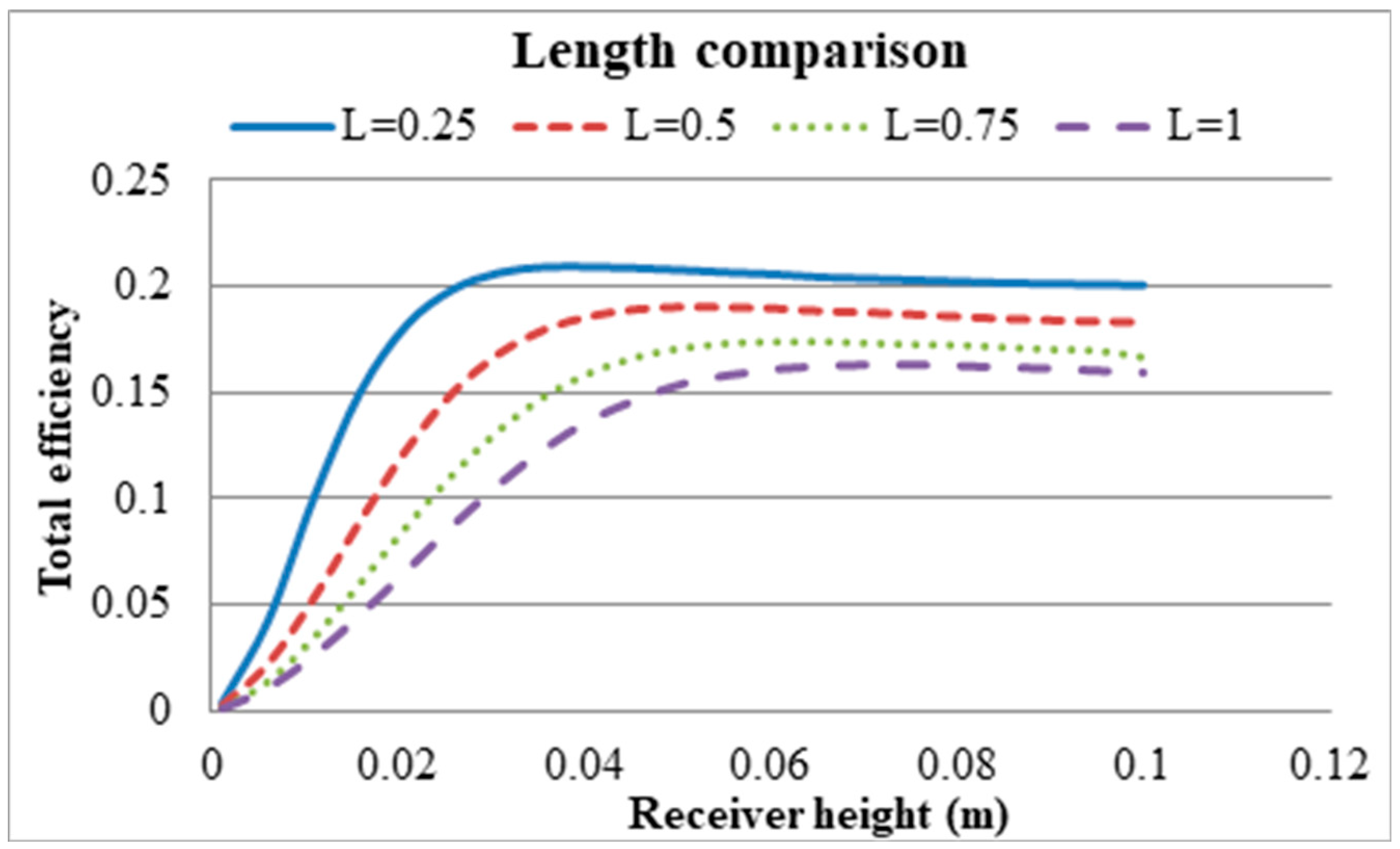
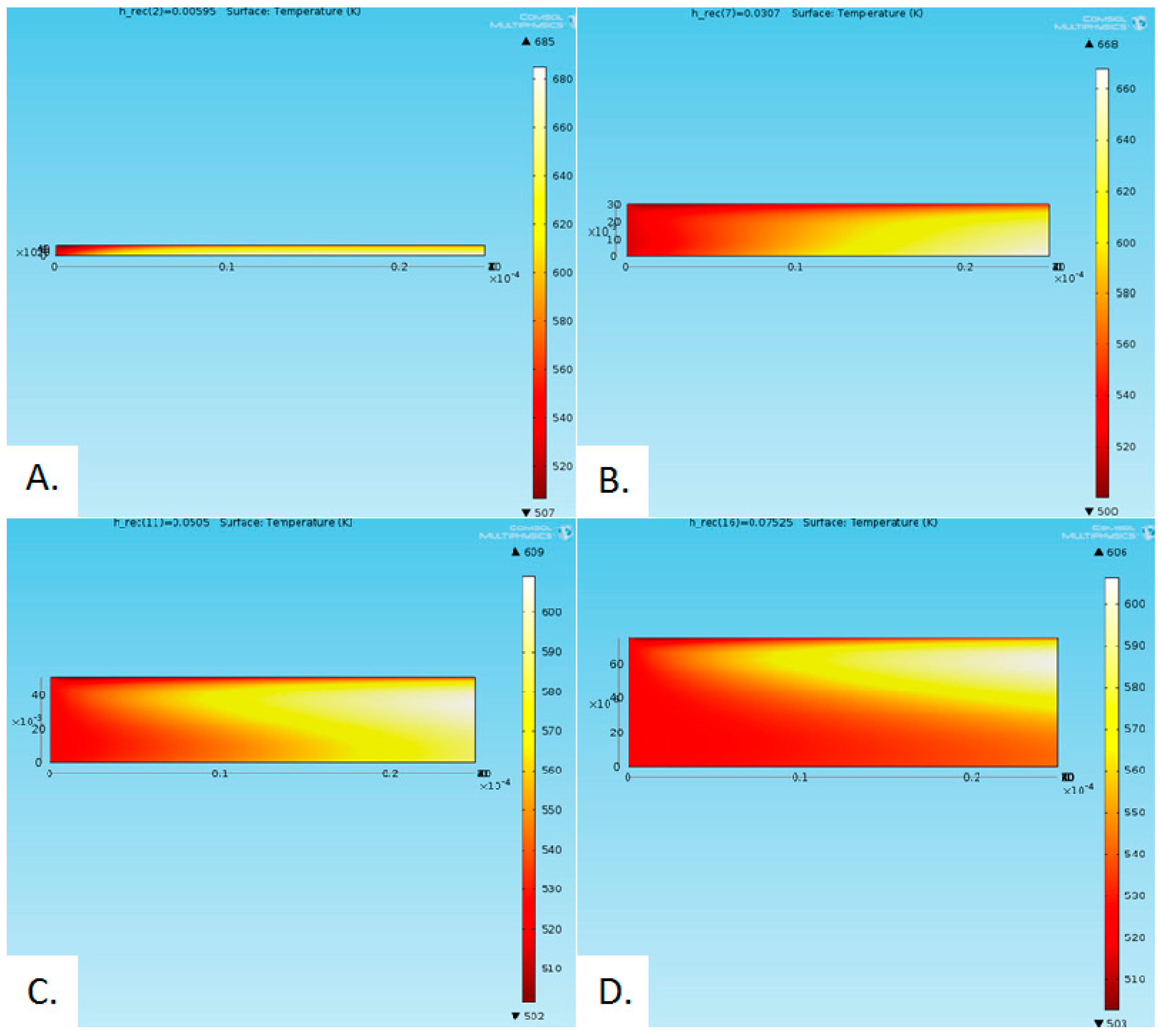
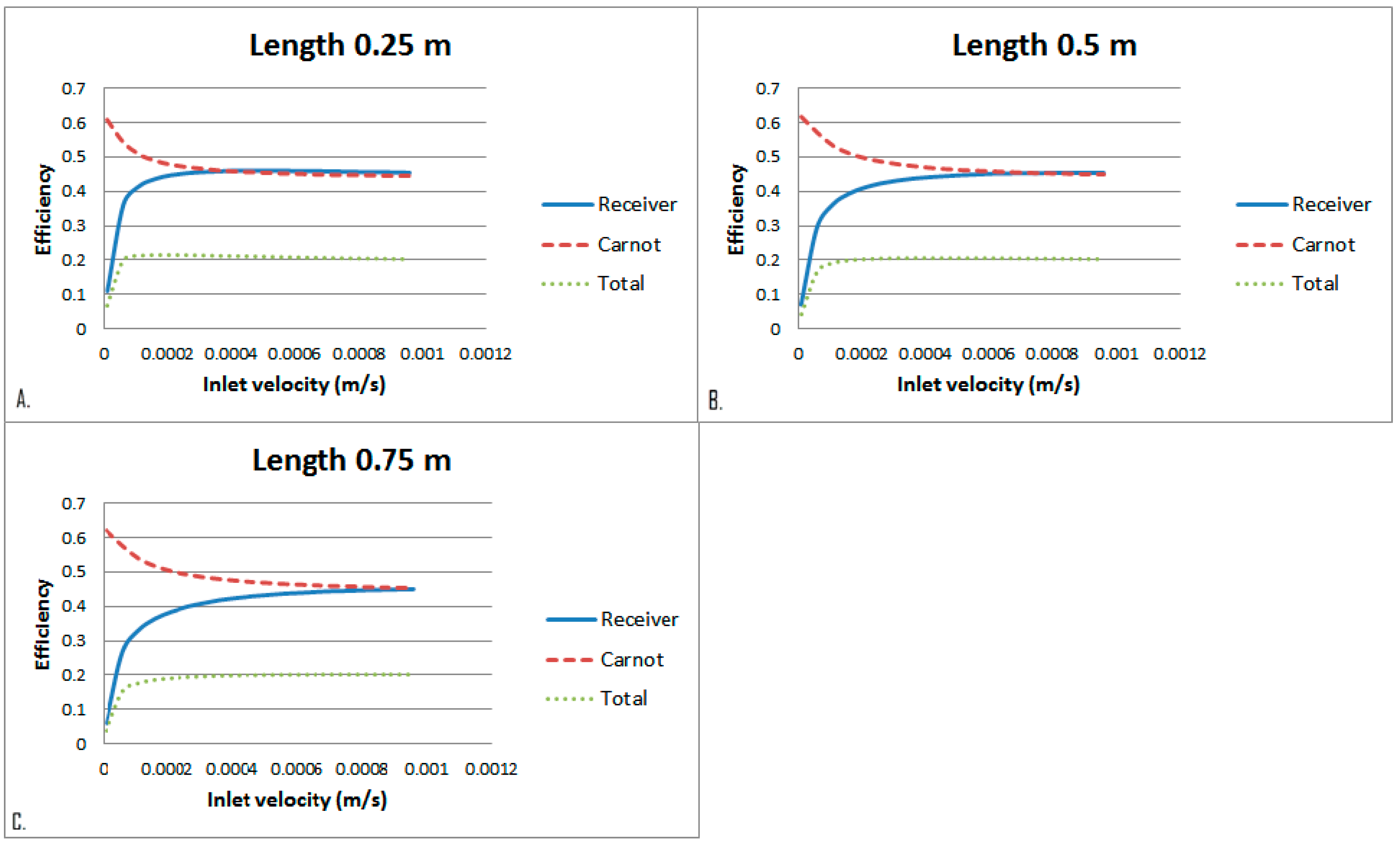
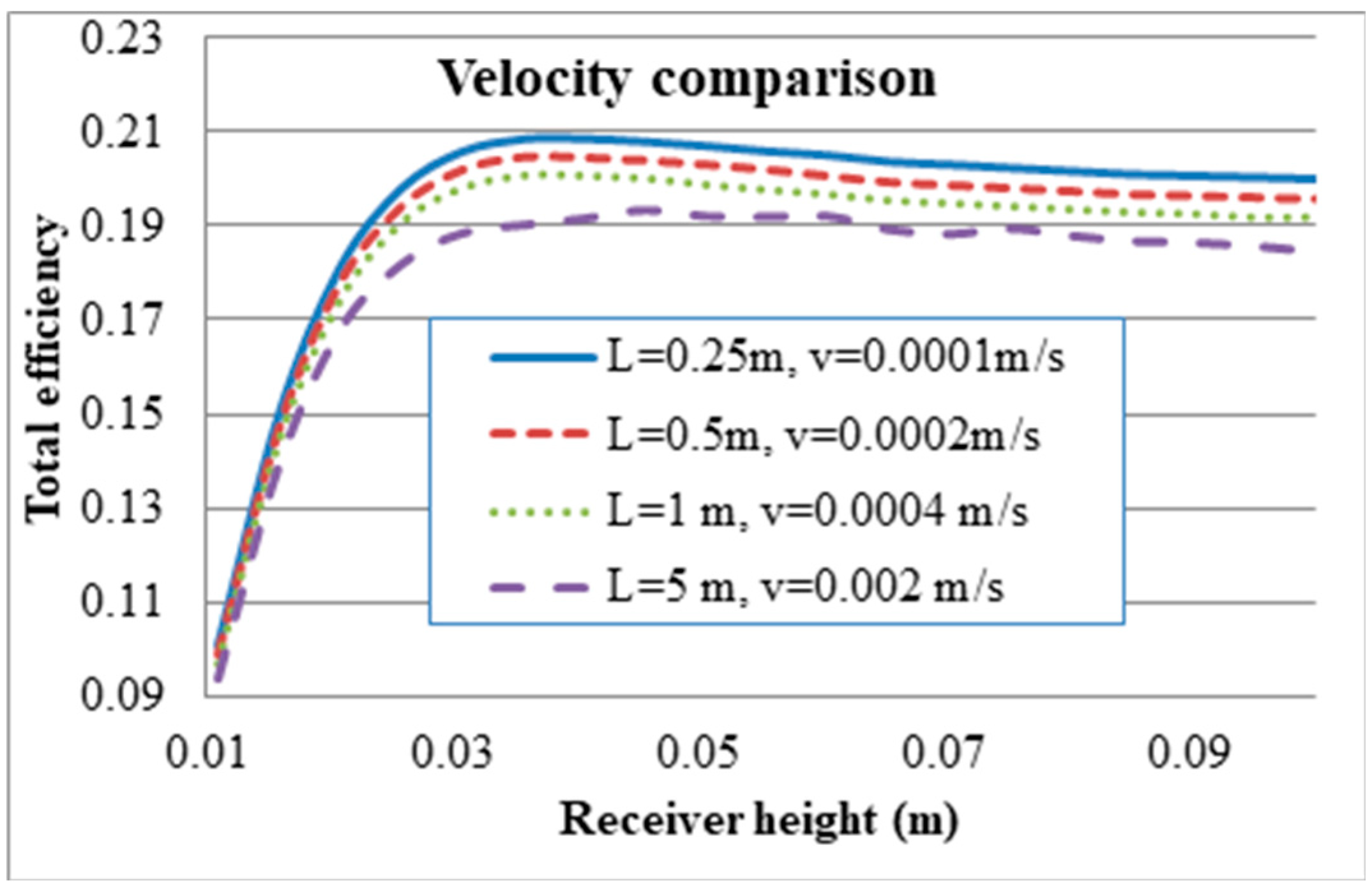
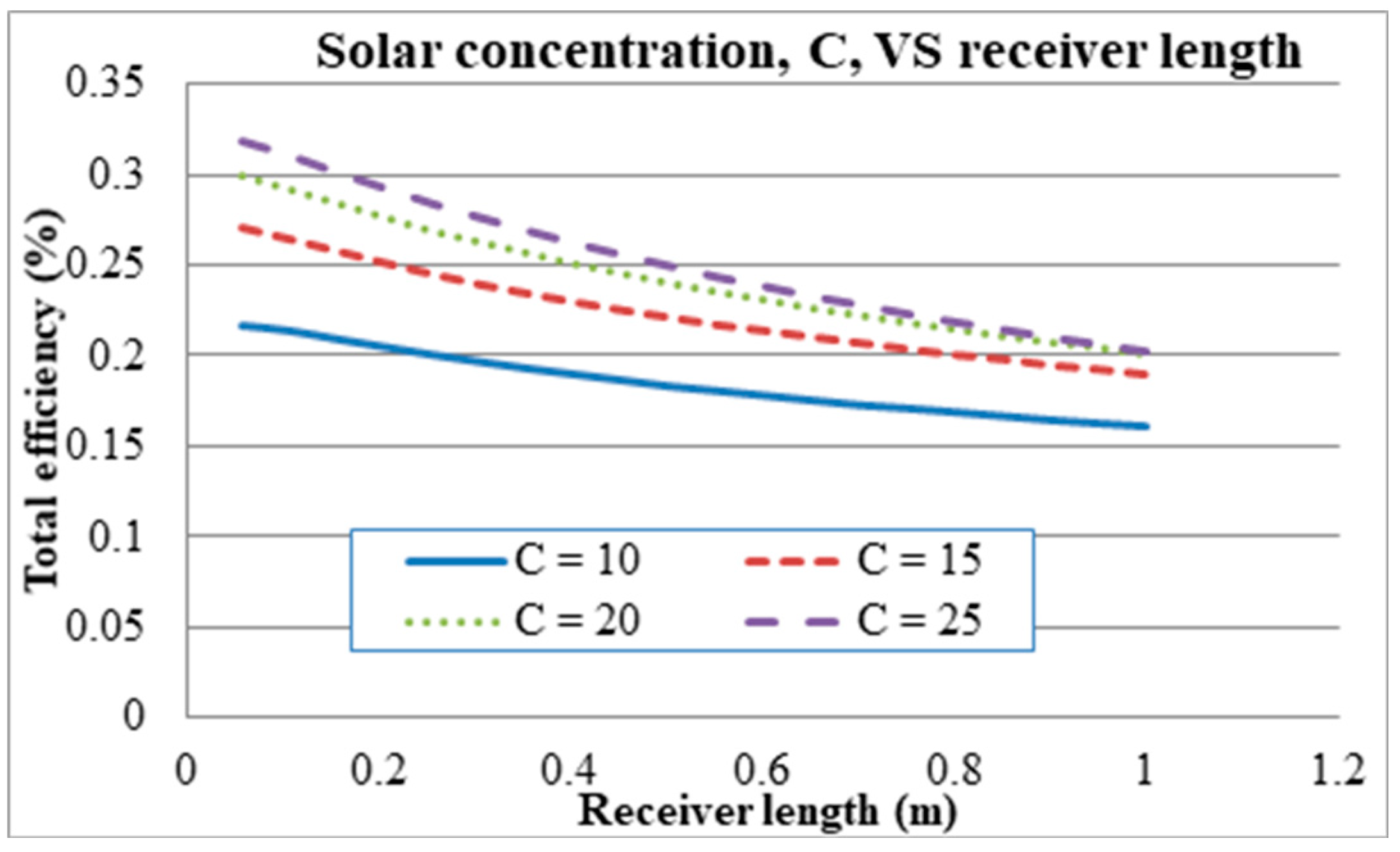
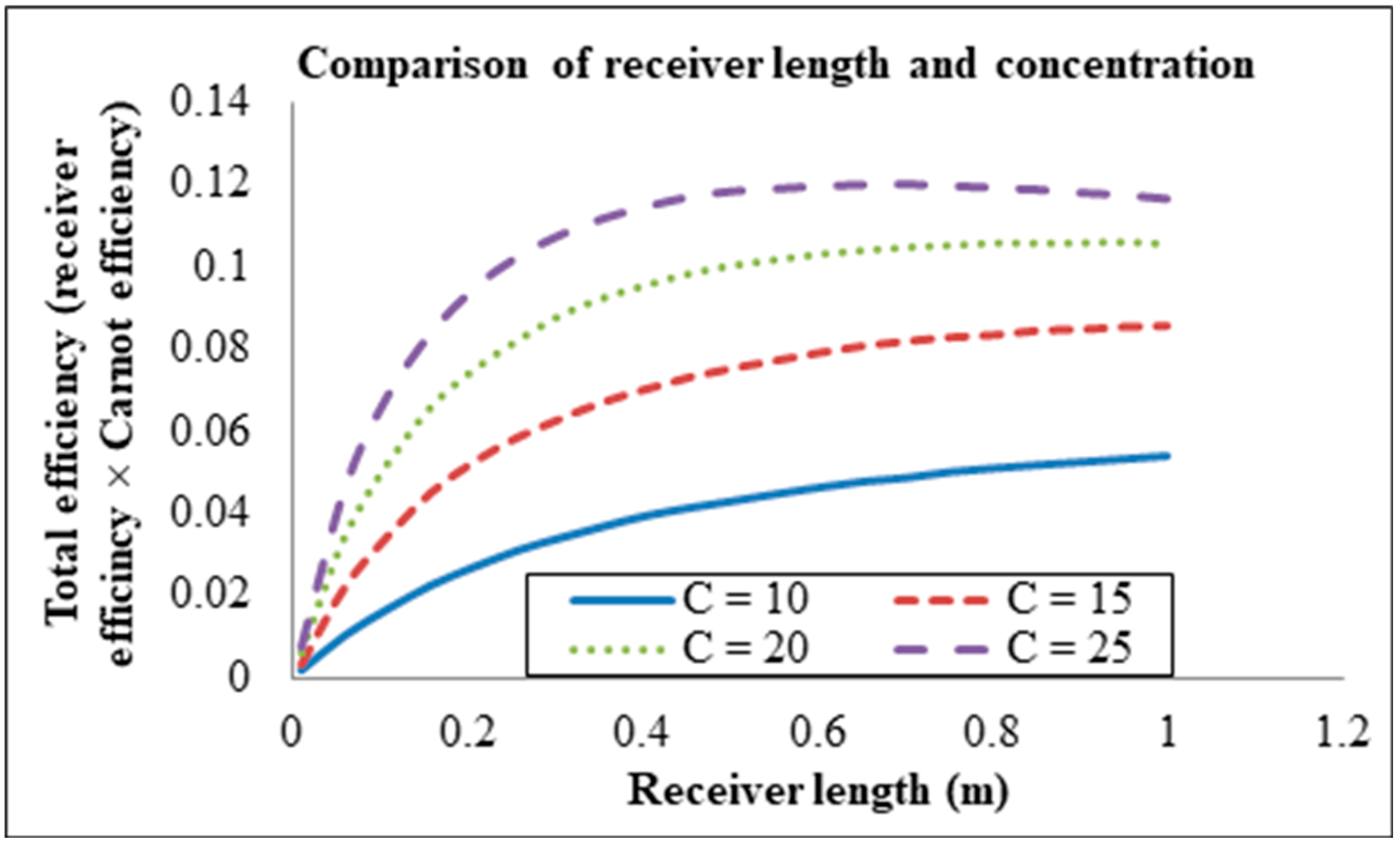
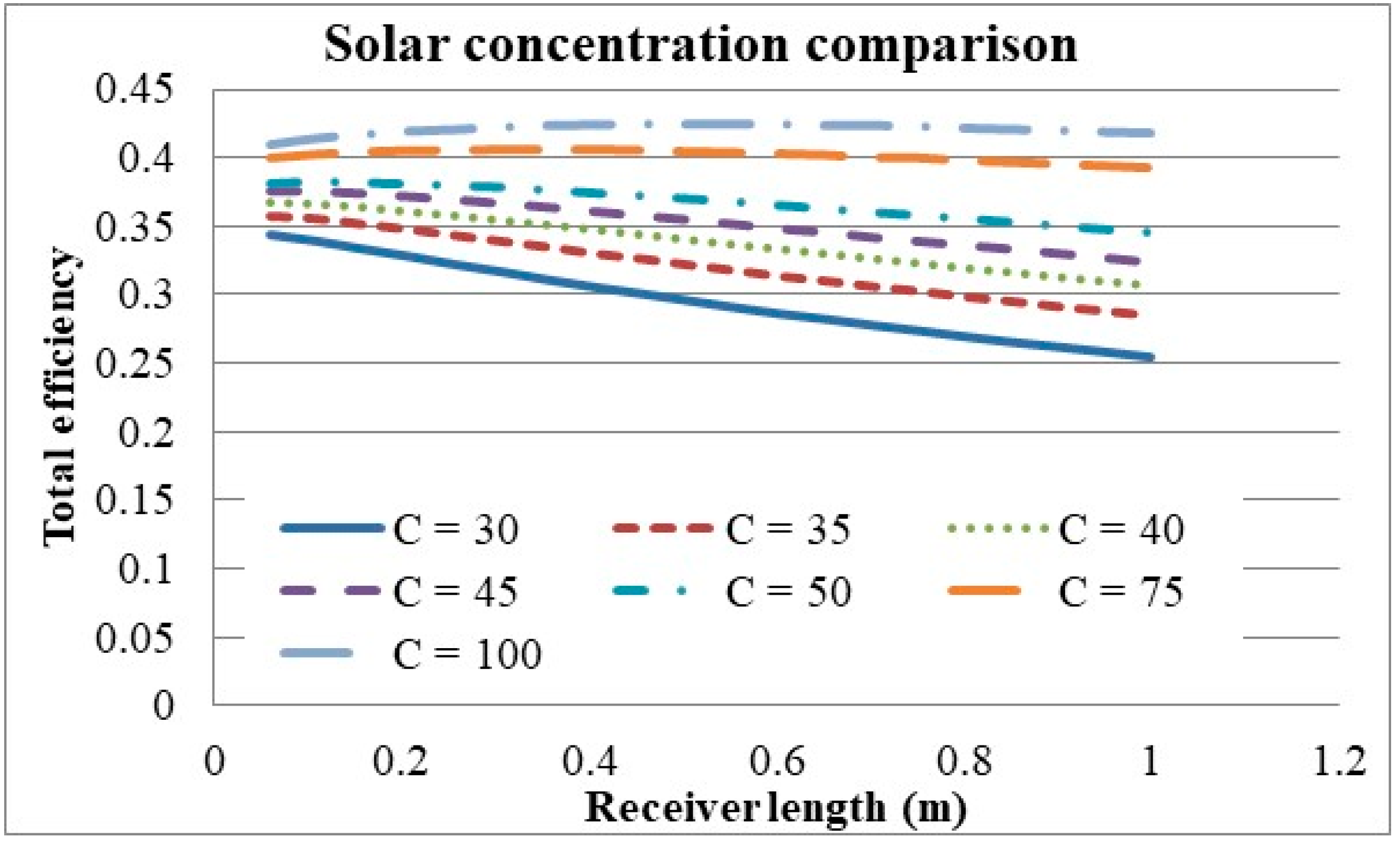
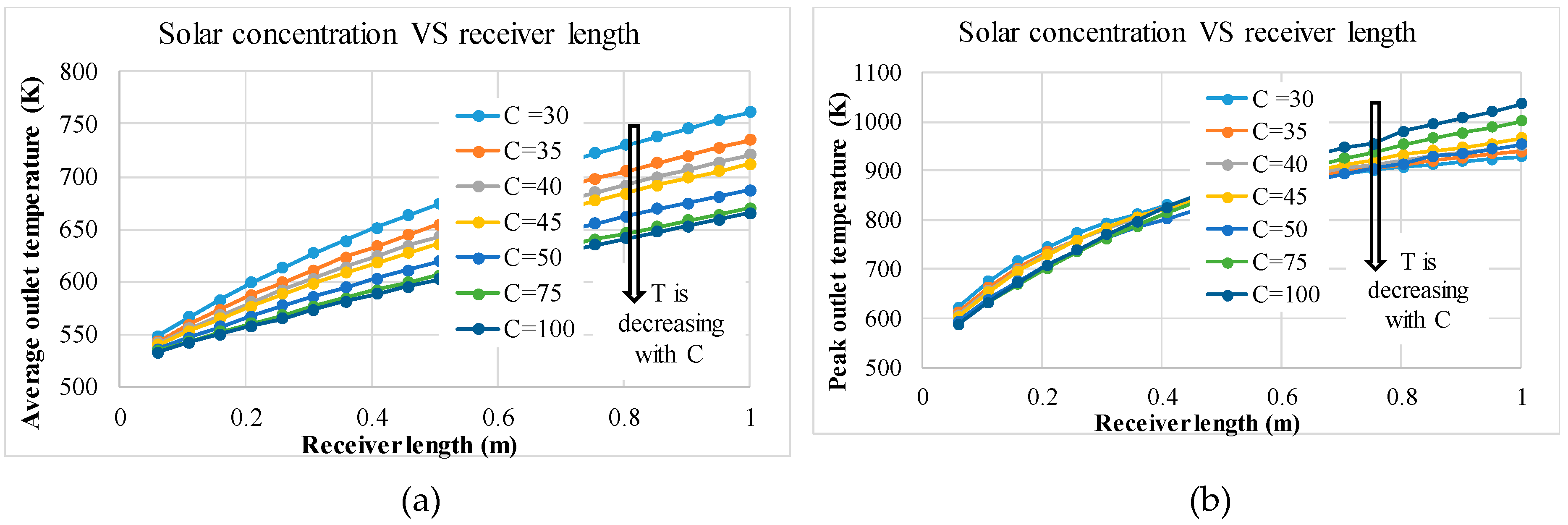
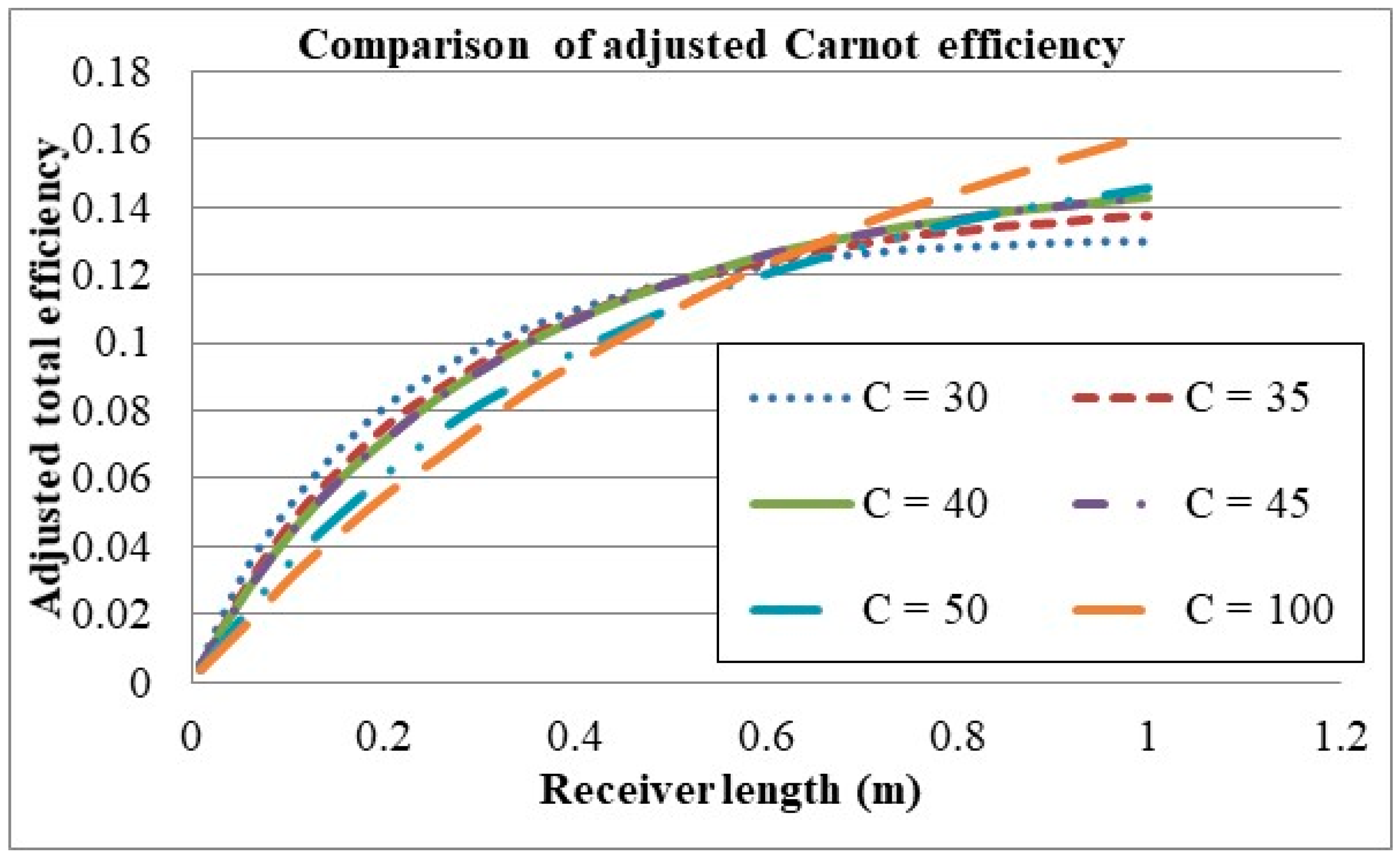
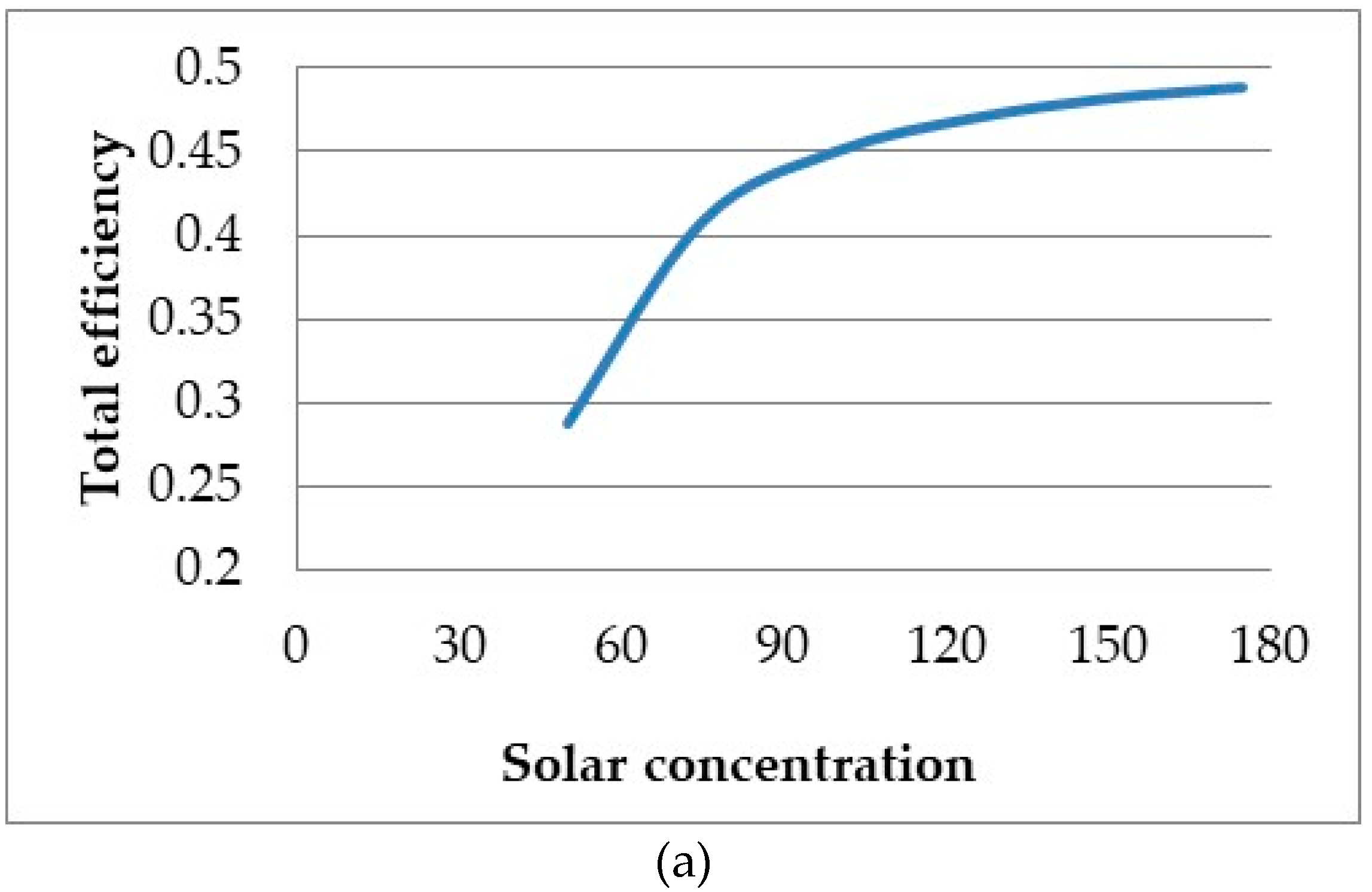
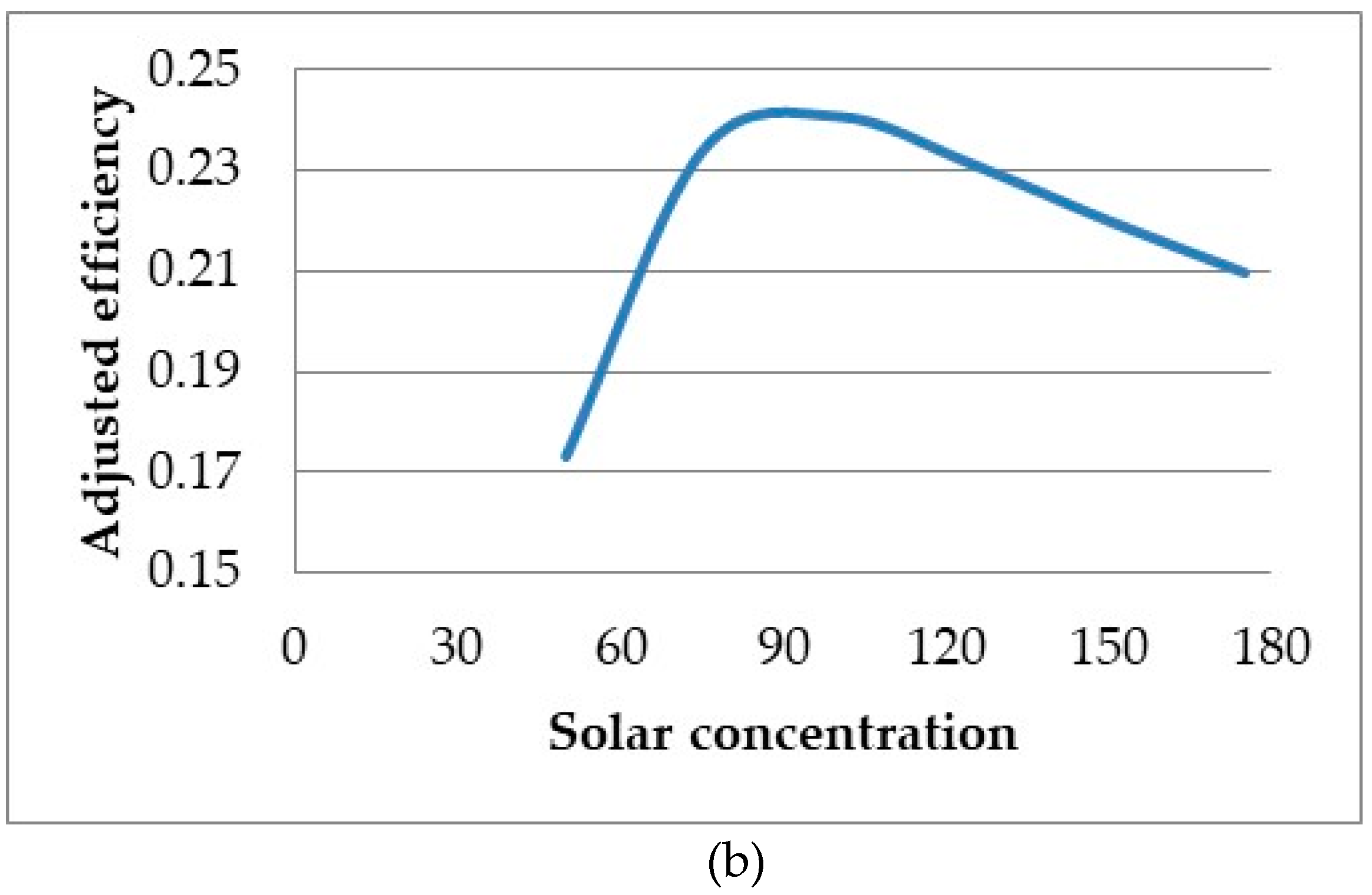
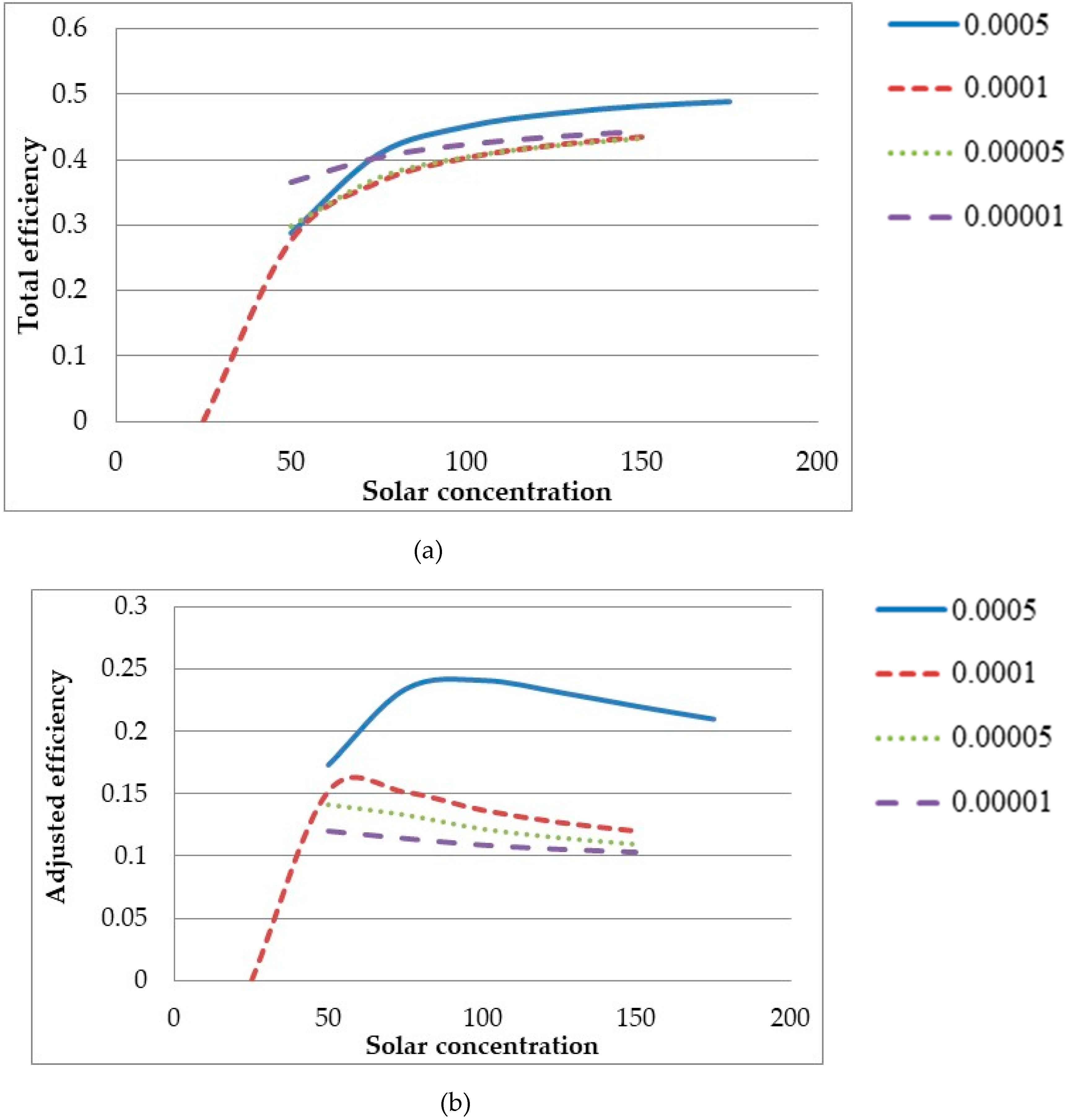

| Name | Expression | Description |
|---|---|---|
| 0.01 (m) | Height of receiver | |
| 0.001 (m) | Width of receiver | |
| 0.04 (m) | Length of receiver | |
| 0.135 (W/mK) | Thermal conductivity of base fluid | |
| 1575 (J/kgK) | Specific heat of base fluid | |
| 1056 (kg/m3) | Density of base fluid | |
| 0.00328 (Pa.s) | Dynamic viscosity of base fluid | |
| 2100 (kg/m3) | Density of nanoparticles | |
| 300 (K) | Inlet temperature | |
| 0.000066 (m/s) | Inlet velocity | |
| D | 50 × 10−9 (m) | Diameter of nanoparticles |
| 0.000634 | Volume fraction of nanoparticles | |
| 0.73 | Attenuation constant | |
| Conc | 10× | Solar concentration (times) |
| 6.8 × 10−5 (steradians) | Solid angle of the sun from Earth | |
| h | 6.62606957 × 10−34 (J.s) | Planck’s constant |
| 1.3806488 × 10−23 (J/K) | Boltzmann constant | |
| 5800 (K) | Temperature of the sun | |
| C | 299792458 (m/s) | Speed of light |
| Ambient temperature | ||
| 2.72 | Refractive index of nanoparticle | |
| 1.31 | Absorptive index of nanoparticle | |
| 1.63 | Refractive index of base fluid | |
| 3.86 × 10−8 | Absorptive index of base fluid | |
| 100 × 10−9 (m) | Lower limit of wavelength range | |
| 1000 × 10−6 (m) | Upper limit of wavelength range | |
| 13.5 (W/m2K) | Combined radiative and convective heat loss coefficient |
| Name | Expression | Description |
|---|---|---|
| λ | Wavelength | |
| Concentrated normally incident solar radiation distribution | ||
| Concentrated normally incident solar radiation | ||
| Distance from surface of receiver | ||
| Relative complex refraction index of nanofluid | ||
| M | Total mass of nanofluid | |
| Absorption efficiency | ||
| Scattering efficiency | ||
| Absorption coefficient of nanoparticles | ||
| Absorption coefficient of base fluid | ||
| Spectral flux | ||
| Divergence of the spectral flux | ||
| Volumetric heat release | ||
| Average outlet temperature | ||
| Efficiency of receiver |
| Receiver Length (m) | Peak Height (m) | Total Efficiency |
|---|---|---|
| 0.25 | 0.0406 | 20.9% |
| 0.5 | 0.0505 | 19% |
| 0.75 | 0.06535 | 17.5% |
| 1 | 0.07525 | 16.3% |
| Solar Concentration (×) | Inlet Velocity (m/s) |
|---|---|
| 30 | 0.00020 |
| 35 | 0.00030 |
| 40 | 0.00040 |
| 45 | 0.00050 |
| 50 | 0.00070 |
| 75 | 0.00135 |
| 100 | 0.00200 |
| Conc. | 30 | 35 | 40 | 45 | 50 | 75 | 100 | |||||||
|---|---|---|---|---|---|---|---|---|---|---|---|---|---|---|
| Temp. | Ave. | Peak | Ave. | Peak | Ave. | Peak | Ave. | Peak | Ave. | Peak | Ave. | Peak | Ave. | Peak |
| L. (m) | ||||||||||||||
| 0.0595 | 548 | 624 | 543 | 613 | 541 | 608 | 540 | 605 | 536 | 594 | 534 | 589 | 533 | 588 |
| 0.109 | 566 | 676 | 559 | 663 | 555 | 656 | 553 | 654 | 547 | 639 | 543 | 633 | 542 | 633 |
| 0.1585 | 583 | 716 | 573 | 702 | 568 | 698 | 565 | 696 | 557 | 676 | 552 | 669 | 550 | 673 |
| 0.208 | 599 | 745 | 587 | 735 | 580 | 731 | 576 | 730 | 567 | 709 | 560 | 702 | 558 | 709 |
| 0.2575 | 613 | 773 | 599 | 760 | 592 | 759 | 588 | 759 | 577 | 737 | 568 | 735 | 565 | 739 |
| 0.307 | 627 | 794 | 611 | 783 | 603 | 783 | 598 | 784 | 586 | 763 | 576 | 763 | 573 | 770 |
| 0.3565 | 639 | 812 | 623 | 804 | 614 | 805 | 608 | 807 | 594 | 786 | 584 | 788 | 581 | 797 |
| 0.406 | 651 | 830 | 633 | 825 | 624 | 824 | 618 | 823 | 603 | 802 | 592 | 814 | 588 | 825 |
| 0.4555 | 663 | 843 | 644 | 840 | 634 | 840 | 627 | 841 | 611 | 820 | 599 | 836 | 595 | 848 |
| 0.505 | 674 | 855 | 654 | 851 | 643 | 853 | 636 | 861 | 619 | 841 | 606 | 855 | 602 | 867 |
| 0.5545 | 684 | 867 | 663 | 865 | 652 | 868 | 645 | 871 | 627 | 854 | 613 | 876 | 609 | 892 |
| 0.604 | 694 | 876 | 672 | 879 | 661 | 882 | 653 | 887 | 634 | 867 | 620 | 893 | 616 | 914 |
| 0.6535 | 704 | 886 | 681 | 888 | 669 | 893 | 662 | 900 | 641 | 881 | 627 | 909 | 622 | 932 |
| 0.703 | 713 | 893 | 689 | 898 | 677 | 905 | 669 | 913 | 648 | 893 | 633 | 925 | 629 | 948 |
| 0.7525 | 722 | 901 | 698 | 906 | 685 | 913 | 677 | 920 | 655 | 905 | 640 | 938 | 635 | 956 |
| 0.802 | 730 | 908 | 705 | 913 | 692 | 923 | 684 | 933 | 662 | 915 | 646 | 954 | 641 | 981 |
| 0.8515 | 738 | 912 | 713 | 920 | 700 | 931 | 692 | 942 | 669 | 930 | 652 | 966 | 647 | 995 |
| 0.901 | 746 | 919 | 720 | 927 | 707 | 938 | 699 | 948 | 675 | 935 | 658 | 977 | 653 | 1008 |
| 0.9505 | 754 | 924 | 728 | 935 | 714 | 945 | 705 | 956 | 681 | 944 | 664 | 988 | 659 | 1021 |
| 1 | 761 | 929 | 735 | 939 | 721 | 953 | 712 | 966 | 687 | 954 | 670 | 1001 | 665 | 1036 |
© 2019 by the authors. Licensee MDPI, Basel, Switzerland. This article is an open access article distributed under the terms and conditions of the Creative Commons Attribution (CC BY) license (http://creativecommons.org/licenses/by/4.0/).
Share and Cite
Karim, M.A.; Arthur, O.; Yarlagadda, P.K.; Islam, M.; Mahiuddin, M. Performance Investigation of High Temperature Application of Molten Solar Salt Nanofluid in a Direct Absorption Solar Collector. Molecules 2019, 24, 285. https://doi.org/10.3390/molecules24020285
Karim MA, Arthur O, Yarlagadda PK, Islam M, Mahiuddin M. Performance Investigation of High Temperature Application of Molten Solar Salt Nanofluid in a Direct Absorption Solar Collector. Molecules. 2019; 24(2):285. https://doi.org/10.3390/molecules24020285
Chicago/Turabian StyleKarim, M. A., Owen Arthur, Prasad KDV Yarlagadda, Majedul Islam, and Md Mahiuddin. 2019. "Performance Investigation of High Temperature Application of Molten Solar Salt Nanofluid in a Direct Absorption Solar Collector" Molecules 24, no. 2: 285. https://doi.org/10.3390/molecules24020285
APA StyleKarim, M. A., Arthur, O., Yarlagadda, P. K., Islam, M., & Mahiuddin, M. (2019). Performance Investigation of High Temperature Application of Molten Solar Salt Nanofluid in a Direct Absorption Solar Collector. Molecules, 24(2), 285. https://doi.org/10.3390/molecules24020285








